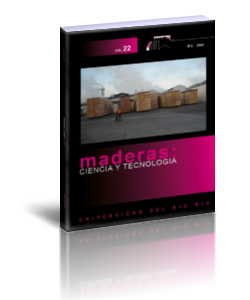Use of nearest neighbors (k–nn) algorithm in tool condition identification in the case of drilling in melamine faced particleboard
Keywords:
Drilling, melamine faced particleboard, k-NN classifier, tool condition identificationAbstract
The purpose of this study was to develop an automatic indirect (non-invasive) system to identify the condition of drill bits on the basis of the measurement of feed force, cutting torque, jig vibrations, acoustic emission and noise which were all generated during machining. The k-nearest neighbors algorithm classifier (k-NN) was used. All data analyses were carried out in MATLAB (MathWorks – USA) environment. It was assumed that the most simple (but sufficiently effective in practice) tool condition identification system should be able to recognize (in an automatic way) 3 different states of the tool, which were conventionally defined as “Green” (tool can still be used), “Red” (tool change is necessary) and “Yellow” (intermediate, warning state). The overall accuracy of classification was 76 % what can be considered a satisfactory result at this stage of studies.
Downloads
References
Fix, E.; Hodges JR, J.L. 1951. Discriminatory analysis, nonparametric discrimination, consistency properties. Project 21-49-004. Report No. 4. USAF School of Aviation Medicine Randolph Field. Texas, USA. URL: https://apps.dtic.mil/dtic/tr/fulltext/u2/a800276.pdf
Górski, J.; Szymanowski, K.; Podziewski, P.; Śmietańska, K.; Czarniak, P.; Cyrankowski, M. 2019. Use of cutting force and vibro-acoustic signals in tool wear monitoring based on multiple regression technique for compreg milling. Bioresources 14(2): 3379–3388. URL: https://ojs.cnr.ncsu.edu/index.php/BioRes/article/view/BioRes_14_2_3379_Gorski_Cutting_Force_Vibro_Acoustic_Signal
Hall, P.; Park, B.U.; Samworth, R.J. 2008. Choice of neighbor order in nearest - neighbor classification. Ann Stat 36(5): 2135–2152. URL: https://projecteuclid.org/euclid.aos/1223908087
Iskra, P.; Hernandez, R. E. 2012. Toward a process monitoring of CNC wood router. Sensor selection and surface roughness prediction. Wood Sci Technol 46(1-3): 115–128. https://doi.org/10.1007/s00226-010-0378-7
Jegorowa, A.; Górski, J.; Kurek, J.; Kruk, M. 2019. Initial study on the use of support vector machine (SVM) in tool condition monitoring in chipboard drilling. Eur J Wood Wood Prod 77: 957-959. https://doi.org/10.1007/s00107-019-01428-5
Lemaster, R. L.; Lu, L.; Jackson, S. 2000a. The use of process monitoring techniques on a CNC wood router. Part 1. Sensor selection. Forest Prod J 50(7/8): 31–38. URL: https://search.proquest.com/docview/214640104/fulltextPDF/8BFC61230D8E4583PQ/1?accountid=17248
Lemaster, R. L.; Lu, L.; Jackson, S. 2000b. The use of process monitoring techniques on a CNC wood router. Part 2. Use of vibration accelerometer to monitor tool wear and workpiece quality. Forest Prod J 50(9): 59–64. URL: https://search.proquest.com/docview/214622388/fulltextPDF/A8F5CD37FAC14C6FPQ/1?accountid=17248
Schwab, K. 2017. The Fourth Industrial Revolution. Portfolio Penguin. London, United Kingdom. 192 p. URL: https://www.penguin.co.uk/books/304/304971/the-fourth-industrial-revolution/9780241300756.html
Szwajka, K.; Górski, J. 2006. Evaluation tool condition of milling wood on the basis of vibration signal. J Phys: Conf Ser 48: 1205–1209. https://doi.org/10.1088/1742-6596/48/1/225
Swiderski, B.; Kurek, J.; Osowski, S.; Kruk, M.; Jegorowa, A. 2017. Diagnostic system of drill condition in laminated chipboard drilling process. In The 21st International Conference on Circuits, Systems, Communications and Computers. MATEC Web of Conferences 125: 04002. https://doi.org/10.1051/matecconf/201712504002
Wagner, T.; Herrmann, C.; Thiede, S. 2017. Industry 4.0 impacts on lean production system. Procedia CIRP 63: 125–131. https://doi.org/10.1016/j.procir.2017.02.041
Wilkowski, J.; Górski, J. 2011. Vibro-acoustic signals as a source of information about tool wear during laminated chipboard milling. Wood Res-Slovakia 56(1): 57–66. URL: http://www.woodresearch.sk/wr/201101/06.pdf

































